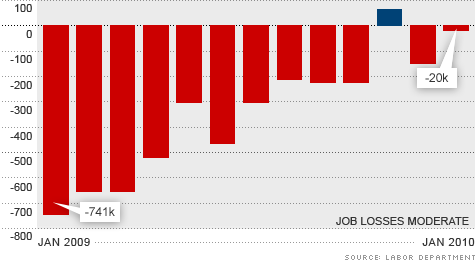Obama Wars
See other Obama Wars Articles
Title: The Real Story Behind Our Unemployment Numbers
Source:
FNC
URL Source: http://www.foxnews.com/opinion/2010 ... -bureau-labor-statistics-grim/
Published: Feb 5, 2010
Author: John Lott
Post Date: 2010-02-05 12:39:45 by Badeye
Keywords: None
Views: 1928
Comments: 13
The Real Story Behind Our Unemployment Numbers By John Lott - FOXNews.com A slight improvement in the jobless rate but what is the government hiding about the picture for most of 2009? print email share recommend (1) Most people seem to believe that the number of Americans with jobs is a clearly identifiable number. All you do is count up the number of people with jobs. Unfortunately, that isn't the way it works. The number reported each month is based on surveys, and surveys have can often have problems. As it turns out, the surveys estimating the number of people with jobs reported over the last couple of years suffered from some really big problems. The economy actually lost about 824,000 more jobs during the recession than we previously thought. But those adjustments have so far only been made through March 2009, and there are strong reasons to believe that the survey data since then also needs to be adjusted downward. There are two ways economists measure the number of jobs, the establishment survey that asks about 370,000 employers how many people they are employing and the household survey that asks about 110,000 people each month whether they are working. The establishment survey is often given more weight because about 40 million Americans work for the companies surveyed, a lot more than the 110,000 people interviewed in the other survey. But 110,000 people still make up a huge sample (remember that a big survey for a presidential election might involve 2,000 people), and it is hard to ignore its results. The household survey is also what is used to calculate the unemployment rate. The problem is that the two surveys have reached different estimates, with the household survey showing a significantly greater drop in the number of jobs than the establishment survey. And it turns out that there might be a simple reason for that. For the survey of firms, the list of firms surveyed doesn't change very often. Thus the Bureau of Labor Statistics, which puts these numbers together, can only guess at the number of jobs created by new firms since they don't even know how many new firms have been created each month. To get around this gap in the data, the Bureau makes an assumption that the jobs created at new companies is about equal to the jobs lost at companies that go out of business. Unfortunately, that assumption hasn't worked during the current recession. Firms have been going out of business and news ones haven't sprung up to take their place. Keith Hall, Commissioner of the Bureau of Labor Statistics, said that most of the revisions made up until March 2009 were made because the number of business closing hasn't been matched by jobs create by new businesses. These recent errors are quite large. The error in estimating the number of jobs from April 2008 to March 2009 was 10 times greater than the average error over the preceding eight years. What does this mean in terms of jobs? Normally the government would underestimate the number of new jobs by 80,000 and this time it was overestimating them by about 800,000. So what is the error rate from April to December 2009? We won't have a good idea until the numbers are revised again in February 2011. In the meantime, we should look at the establishment survey numbers with a great deal of skepticism. For example, the Bureau of Labor Statistics assumes that new firms generated almost a million new jobs over those nine months. As it turns out, the household survey just happens to show that about a million more jobs were lost than the survey of firms indicates. Given these problems, what should people look for to understand what is happening to the economy? The most accurate measure of how well things are going is the unemployment rate and the numbers showing how many people have been so discouraged while looking for a new job that they have left the labor force altogether. With today's numbers showing that the unemployment rate is now at 9.7 percent and that 200,000 fewer Americans have stopped looking for work, the recent picture has finally improved slightly. John R. Lott, Jr. is a FOXNews.com contributor. He is an economist and author of "Freedomnomics."
Post Comment Private Reply Ignore Thread
Top • Page Up • Full Thread • Page Down • Bottom/Latest
Begin Trace Mode for Comment # 4.
#4. To: Badeye (#0)
There are no replies to Comment # 4. End Trace Mode for Comment # 4.
Top • Page Up • Full Thread • Page Down • Bottom/Latest
Replies to Comment # 4.
[Home] [Headlines] [Latest Articles] [Latest Comments] [Post] [Mail] [Sign-in] [Setup] [Help] [Register]
